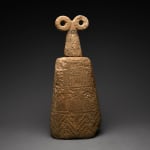Chalcolithic Basalt Eye Idol, 4000 BCE - 3000 BCE
Basalt
height 48.9 cm
height 19 1/4 in
height 19 1/4 in
X.0047
Further images
In 1937, archaeological excavations in Northern Syria at the site of Tell Brak uncovered evidence of the “Eye Temple,” named after the hundreds of small eye idols found fixed into...
In 1937, archaeological excavations in Northern Syria at the site of Tell Brak uncovered evidence of the “Eye Temple,” named after the hundreds of small eye idols found fixed into the mortar of the temple itself. Located off a tributary of the Euphrates River, Tell Brak was one of the first large cities in Mesopotamia that would later serve as an administration center for the Akkadian Empire. However, even during the Chalcolithic era, the region of Northern Syria was an extremely important center for trade, linking the civilizations of Babylon with the mountainous areas of modern-day Turkey.
Little is known about eye idols and their name derives solely from their appearance. Shaped like a weight surmounted by two eyes, much scholarly conjecture has been proposed about their meanings. Some see them as the earliest link to wide-eyed figurative idols that would become popular in later millennia. It is noted that the state of open eyes on a religious idol symbolized devotion to the gods. Thus these little stone eye idols might have been some of the earliest devotional objects from the Near East. Other scholars believe that their function might have been more practical. It is believed that some of the larger idols with drilled holes in them may have served as aids in twisting threads of wool or linen into chord. It is also possible that the round features assumed to be eyes may actually be breasts, and the base in fact a torso.
This imposing basalt eye idol dates from the Chalcolithic era, the intermediate period after the advent of stone tools and before the beginning of the Bronze Age. This was an age of experimentation, when metalworking was slowly perfected, giving rise to the Bronze Age. The incised decorations carved onto the surface of this basalt idol seem highly abstracted and offer little assistance in clarifying the interpretation of this piece. Perhaps we must simply accept that this work will remain shrouded in mystery. Large and formidable, especially when compared to the small eye idols that number in the hundreds found in the ruins of the “Eye Temple,” this work clearly played a significant role in its day, whether that role was as mundane as creating rope or a sacred as the central image of a fertility cult.
Little is known about eye idols and their name derives solely from their appearance. Shaped like a weight surmounted by two eyes, much scholarly conjecture has been proposed about their meanings. Some see them as the earliest link to wide-eyed figurative idols that would become popular in later millennia. It is noted that the state of open eyes on a religious idol symbolized devotion to the gods. Thus these little stone eye idols might have been some of the earliest devotional objects from the Near East. Other scholars believe that their function might have been more practical. It is believed that some of the larger idols with drilled holes in them may have served as aids in twisting threads of wool or linen into chord. It is also possible that the round features assumed to be eyes may actually be breasts, and the base in fact a torso.
This imposing basalt eye idol dates from the Chalcolithic era, the intermediate period after the advent of stone tools and before the beginning of the Bronze Age. This was an age of experimentation, when metalworking was slowly perfected, giving rise to the Bronze Age. The incised decorations carved onto the surface of this basalt idol seem highly abstracted and offer little assistance in clarifying the interpretation of this piece. Perhaps we must simply accept that this work will remain shrouded in mystery. Large and formidable, especially when compared to the small eye idols that number in the hundreds found in the ruins of the “Eye Temple,” this work clearly played a significant role in its day, whether that role was as mundane as creating rope or a sacred as the central image of a fertility cult.







